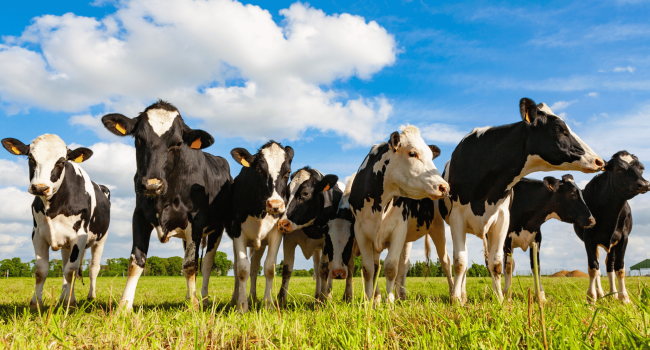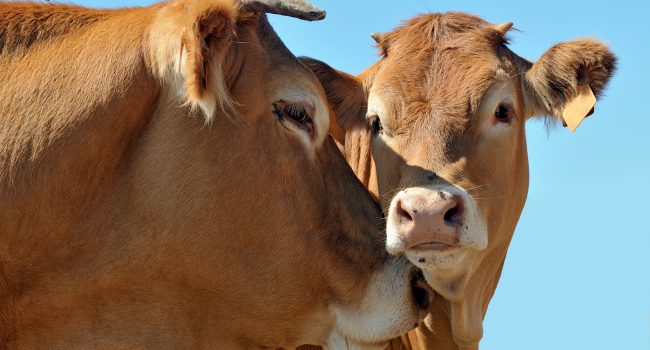A key target for minimizing the impact of the climate crisis on global ecosystems and human economies is to reach carbon neutrality by 2050 (Rogelj et al., 2018).
For this, reductions to near-zero emissions of carbon dioxide (CO2) and non-CO2 greenhouse gases (GHG) are necessary.
Stakeholders are supporting this change, to the point that 92% of GenZ consumers say they would switch to brands that support environmental and social issues (GenZ SCR Study, 2017).
Energy and transport are not the only factors responsible for climate change – agriculture alone accounts for 24% of global greenhouse gas emissions; in particular, the livestock sector generates methane, one of the most potent GHGs and a significant driver of climate change (Gerber et al., 2013).
Ruminants and greenhouse gas (GHG) emissions
While ruminants play an important role in providing high quality protein essential for human diets, they are a significant source of greenhouse gas emissions.
As mentioned above, with 25 times the warming effect of carbon dioxide, the largest source is methane (CH4) resulting from enteric fermentation and accounting for about 47% of the sector’s emissions and more than 90% of the total methane emissions.
This originates from microbial communities fermenting plant biomass in the rumen.
In this process, hydrogen and CO2 can be converted into nutrients by beneficial bacteria, or into methane by methanogenic archaea (McAllister and Newbold, 2008).
Methane production uses 2-12% of the gross dietary energy and represents a substantial metabolic loss to the ruminant (Johnson and Ward, 2008).
Alongside methane emissions, nitrous oxide (N2O) originating mainly from food production and N deposited during grazing represents 24% of the sector’s greenhouse gas emissions.
Emissions from land-use change associated with the expansion of grassland into forest account for 14.8% of total GHG emissions related to beef cattle production.
To this must be added further CO2 which is emitted by tractors and other agricultural machinery, and, in the post-farm stages of feed production, carbon dioxide is emitted in conjunction with various feed processes (e.g. drying) and transport.
In general, CO2 emissions from energy use in feed production, processing and transport are strongly correlated to the food ration (Opio et al., FAO, 2013).
It has been found that differences in emission intensities are driven by a combination of various factors (Ortega et al., 2021):
- At the animal level, emission intensity is influenced by: (i) the digestibility, quality and composition of the feed ration, which influence the level of enteric methane emissions and manure emissions (lower release of nitrogen and volatile solids) per unit of product produced (milk or weight gain); and (ii) improved genetics and animal health which contribute to better conversion of feed into animal products, further reducing emission intensity. Still at the animal level, emission intensity is also influenced by reproduction strategies (replacement, age at first calving) which reduce the relative number of unproductive animals in the herd and thus the emissions per unit of product generated at herd level.
- Land-use change, e.g. pasture expansion, is a major driver of GHG emissions. Feed originating from areas where land-use change takes place has higher emission intensities.
- Finally, manure management practices also influence the release of methane and nitrous oxide.
It is noteworthy that, among the edible commodities produced by ruminant systems, milk generally has a lower emission intensity compared to meat, suggesting that dairy systems are more efficient than pure meat systems.
This is because dairy herds produce both milk and meat while beef cattle systems are maintained mainly for calf production.
Reducing GHG emissions
Therefore, among the available mechanisms for reducing GHG emissions, focus can be placed on:
- Replacing regular animals with low-methane genotypes. Some animals have genetic traits that can reduce enteric methane emissions by favouring beneficial microbial communities (Wallace et al., 2019) or increasing animal productivity per unit of feed.
Programs for promoting selective breeding are already in place worldwide, but this is a slow and expensive process that can take decades before establishing a particular genotype (Walsh and Cowley, 2016); - Improving feeding practices, digestibility of diets, animal health, and overall management.
For example, as the digestibility of the feed ration increases, the amount of energy available to the animal also increases per kg of food intake.
With an increase in energy per kg of feed intake, more production can be achieved with a concomitant reduction in methane production; - Methods for inhibiting methane production in the rumen.
The existing strategies for removing methanogenic communities in the rumen are usually neither practical nor sustainable (defaunation), or are even banned (antibiotics), so other approaches focus on inhibiting methane production rather than eliminating the methanogens via the use of probiotics, digestibility enhancers and chemical or natural supplements (Jouany and Morgavi, 2007); - Grassland conversion to silvopasture (Jose and Dollinger, 2019), which consists of the introduction of trees and shrubs within the pasture grassland, with additional environmental benefits such as atmospheric CO2 capture from increased plant biomass production.
Leguminous, high-quality grasses and other silvopastoral plants are rich in tannins and saponins – metabolites that inhibit methanogenic populations in the rumen, improve nutrient absorption and reduce methane emissions (Cieslak et al., 2013); - Improving manure management, by reducing the use of uncovered liquid manure management systems (MMSs), particularly in dairy systems; and
- Improving the efficiency of feed crop production, particularly improving fertilization management.
Conclusion
Different greenhouse gas mitigation strategies are available for ruminant enteric methane, and their feasibility varies with the geographical distribution of natural and economic resources.
Although some strategies are already in place, implementation of others lags behind despite their strong mitigation potential.
This delay is due in part to the economic inequality that impedes studies on ruminants.
Such research requires long experimental timescales and a holistic understanding of their implications on ruminant subjects, the environment and human health (Ortega et al., 2021).
Uncertain yield benefits, risks in applying new practices, implementation costs, but also the lack of approved carbon accounting methodologies and monitoring tools to certify carbon reductions, and the lack of awareness regarding the financial support of low carbon strategies, also curb the adoption of low-carbon practices.
As CO2 remains in the atmosphere for a hundred years, and methane for only twelve (US Environmental Protection Agency), if the world’s livestock population were to be reduced, the results on atmospheric methane concentrations would be very rapid.
Sustainability and health concerns are thus helping to drive the flexitarian (or semi-vegetarian) trend of eating, seeking to reduce beef cattle meat, especially among GenZ and GenY younger adults.
This information is intended for informational purposes only and does not imply any warranty related to or express recommendations for the cure, mitigation, treatment, or prevention of disease.
![[EN] Blog - How to reduce ruminant greenhouse emissions?](https://www.premix.adm.com/wp-content/uploads/2022/10/Dairy-cows-AdobeStock_289576562-scaled-1800x600.jpeg)




